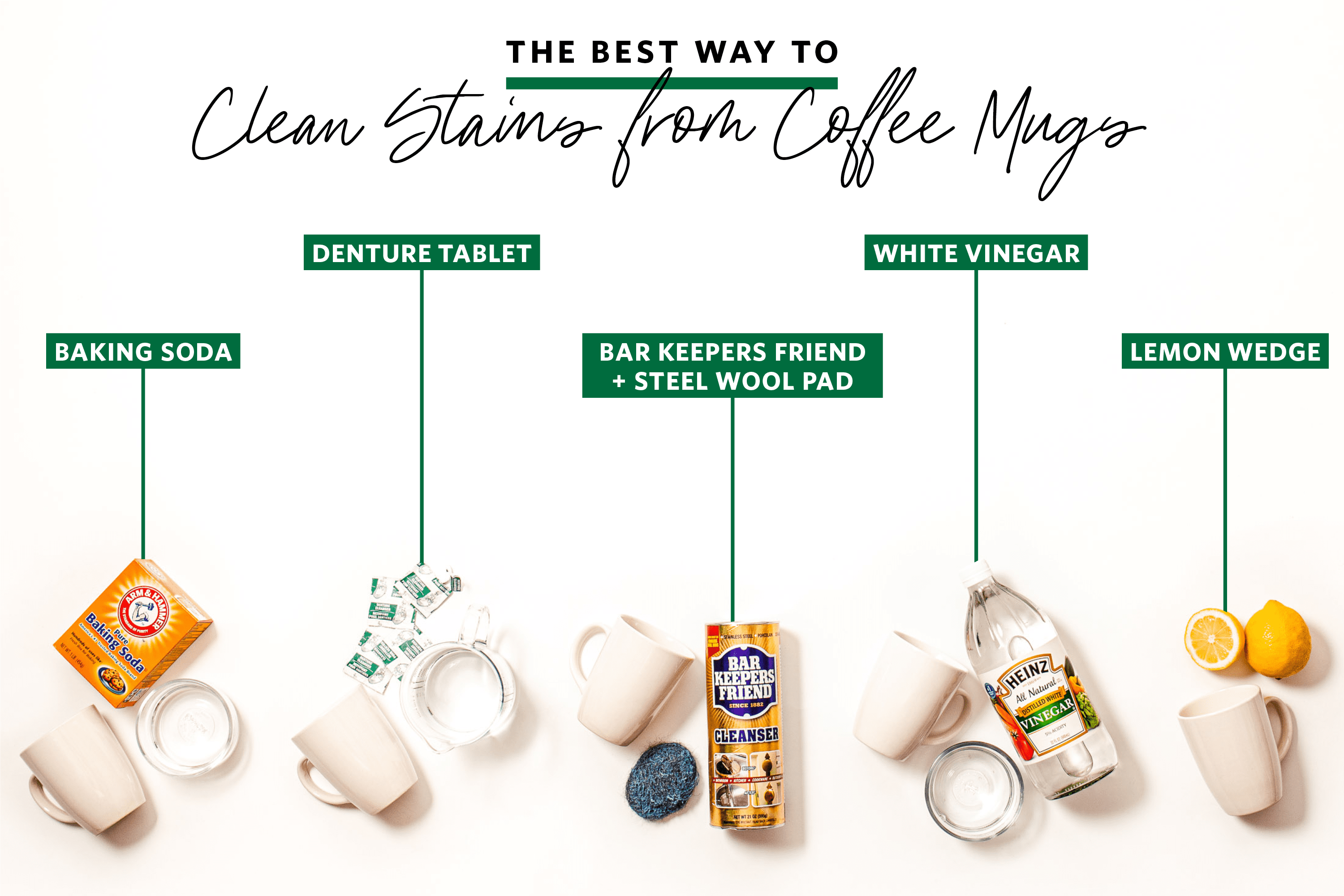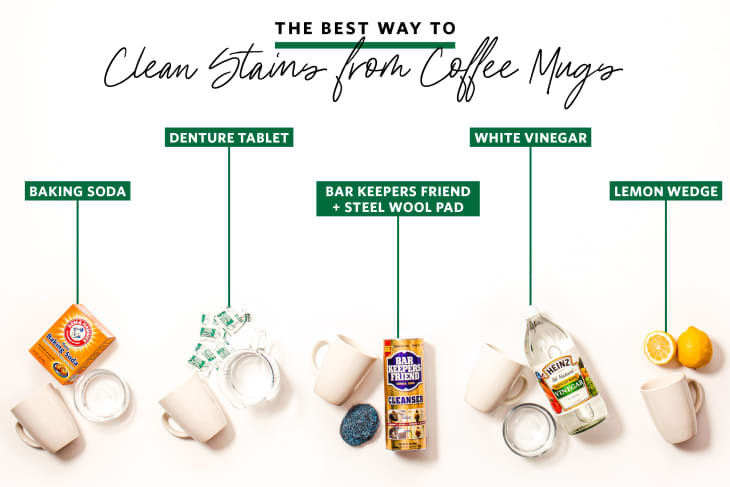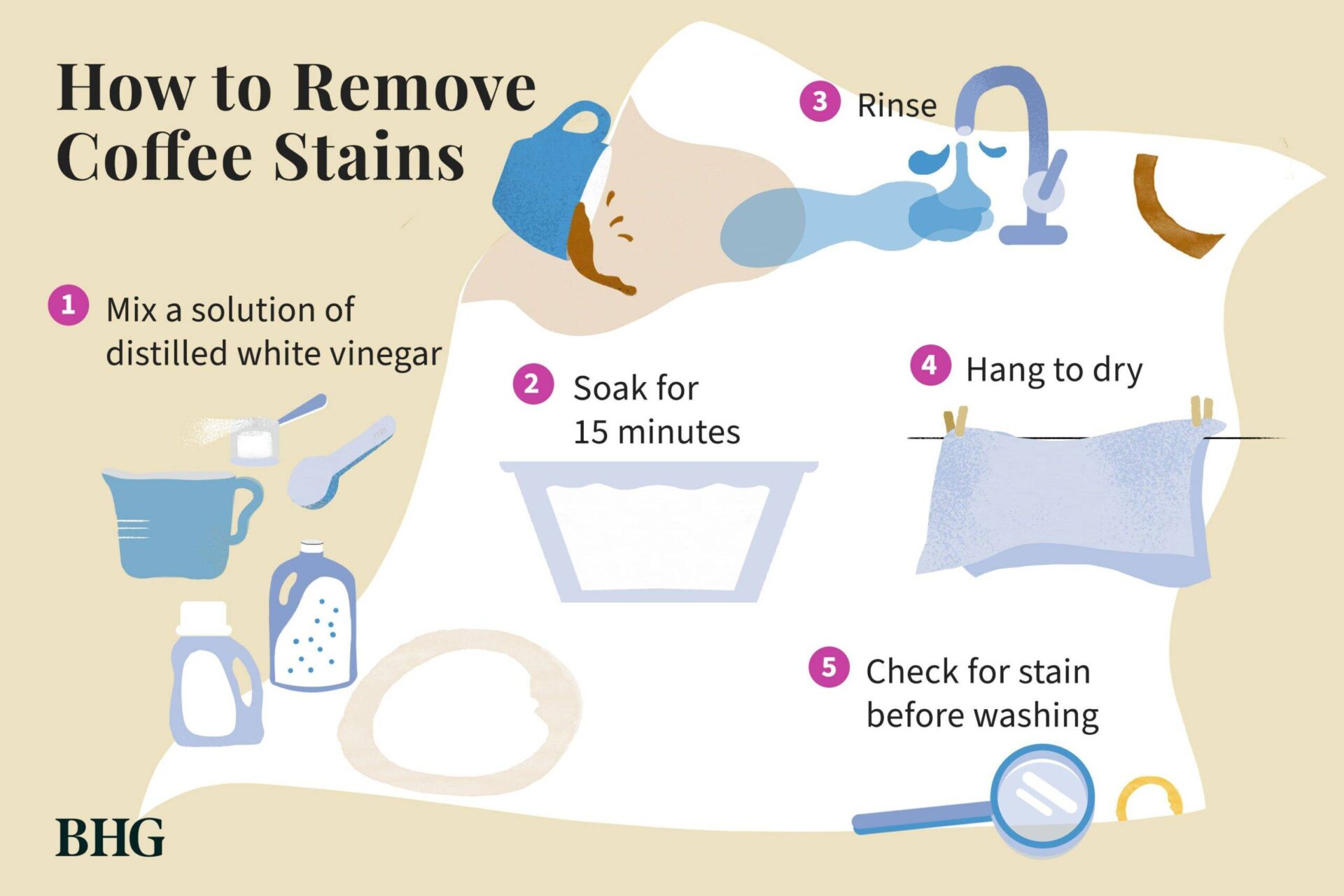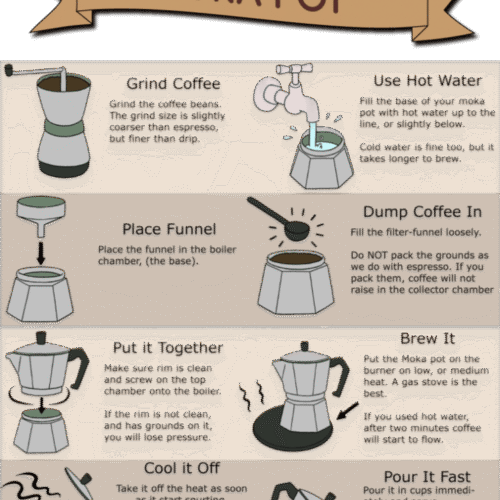To remove coffee stains, blot the area with a mixture of water and vinegar, then wash as usual. Use a gentle circular motion when treating the fabric to avoid damaging it.
Removing a coffee stain can often feel like an urgent task, especially if it’s on a favorite shirt or piece of furniture. Coffee, with its dark color and strong pigments, can leave a noticeable mark, making quick action essential. A simple solution of everyday household items like vinegar and water can work miracles in lifting the unsightly blemish.
Ensuring the stain does not set in requires immediate attention, and it’s always best to treat it before the coffee dries up. Whether it’s a fresh spill or an old, dried stain, with the right approach, you can restore your fabrics back to their original state. Remember to always check the care label on your garment or fabric for specific washing instructions to prevent any damage during the cleaning process.
:max_bytes(150000):strip_icc()/remove-coffee-stains-from-clothing-1901014-v3-ebd5912d0b4b43de936c73c29e1c45eb.png)
Credit: www.thespruce.com
Introduction To Coffee Stains
There’s nothing quite like a fresh cup of coffee to start your day. But accidents happen, often leaving an unwelcome souvenir on your clothes, carpet, or favorite mug: coffee stains. Understanding these stubborn spots is the first step in battling them.
The Science Of Coffee Stains
Coffee stains are fascinating to scientists. Coffee is a mixture containing water, oils, and compounds like caffeine and tannins. As liquid evaporates, solids from the coffee concentrate at the edges, creating a ring-like pattern often seen in dried coffee spills. This is the notorious coffee stain ring.
Why Coffee Stains Are Challenging To Remove
The difficulty in removing coffee stains stems from their composition. Tannins, which are plant-based compounds, bind to fabric fibers on a molecular level, making them particularly pesky. The longer a stain sits, the harder it becomes to remove, as the tannins further set into the material.

Credit: www.thekitchn.com
Pre-treatment Steps
Welcome to the essential guide on pre-treatment steps for coffee stain removal. Quick action can mean the difference between a faint memory and a stubborn reminder on your favorite clothing or fabric. Follow these simple steps to tackle coffee stains effectively.
Immediate Actions After A Spill
Don’t wait when a coffee spill happens. Act fast to prevent the stain from setting. Blot, don’t rub, the excess coffee with a clean, dry cloth. Avoid using colored towels, as they may bleed dye onto the material. Gently blotting reduces the stain and stops it from spreading further.
Assessing The Type Of Material Stained
Different materials need different care. Check the label for washing instructions. Identify the fabric type: cotton, wool, silk, synthetic, or upholstery. Each fabric will have specific cleaning methods that work best. Match your cleaning technique to the material for the best results.
Gathering Necessary Supplies
- Mild detergent or stain remover
- Clean cloths or paper towels
- Cold water
- A small bowl for pre-treatment solutions
- An old toothbrush for gentle scrubbing
Assemble these items before you start the stain removal process. Having everything at hand streamlines the task. Ensure your cleaning agents are appropriate for the fabric. Test a small hidden area if unsure.
Removing Coffee Stains From Clothing
No matter how careful you are, coffee stains seem to find their way onto your favorite clothes. But with the right approach, even the most stubborn stains will be long forgotten. Let’s dive into the steps to rescue your beloved garments.
Step-by-step Process For Washable Fabrics
- Rinse the stain with cold water from the back to push the coffee out.
- Apply a stain remover or liquid laundry detergent directly to the stain.
- Gently rub the solution in with your fingers or a soft-bristled brush.
- Let it sit for 3-5 minutes. For older stains, soak up to 30 minutes.
- Wash the fabric according to care instructions using the hottest water safe for the fabric.
- Check the stain before drying. Repeat steps if necessary.
Natural Solutions For Delicate Textiles
- Blot the stain with a dry towel. Avoid rubbing to prevent spreading.
- Make a paste using baking soda and water.
- Apply the paste gently on the stain and let it dry.
- Brush off the residue using a soft brush. If the stain persists, rinse with cold water.
Special Considerations For Colored And White Garments
| Garment Type | Treatment |
|---|---|
| Colored | Test stain remover on a hidden area to ensure color fastness. |
| White | User diluted bleach as a last resort. Rinse thoroughly after application. |
Important: Always read the fabric care label before attempting any stain removal method.
Tackling Coffee Stains On Upholstery
Spilled your morning brew on the sofa? Fear not!
Quick action can save your upholstery from permanent coffee stains.
With the right steps and products, your furniture can look spotless again.
Guidelines For Synthetic Vs. Natural Upholstery
Check the label first. It tells you what fabric you have.
Synthetic fabrics like polyester can handle most cleaners.
Natural fabrics like cotton need gentler care.
| Fabric Type | Cleaning Solution |
|---|---|
| Synthetic | Diluted dish soap or upholstery shampoo |
| Natural | White vinegar and water mix |
Homemade Remedies And Commercial Cleaners
Sometimes, simple ingredients work just as well as store-bought cleaners.
- Baking soda and water lift stains and eliminate odors.
- Use 3 parts water to 1 part vinegar for a DIY solution.
- Commercial cleaners can be powerful. Always test a small area first.
Follow instructions on commercial products for the best results.
Preventing Future Stains On Upholstered Furniture
Here are tips to keep your furniture clean:
- Avoid eating and drinking on upholstered furniture.
- Use stain-repellent products for added protection.
- Clean spills immediately to prevent the stain from setting.
Vacuum regularly to prevent dirt buildup that can make stains worse.
Addressing Stains On Carpet
Accidents happen, and coffee is often the culprit. Your cozy carpet is not immune to spills, but no stain needs to be permanent. Tackling coffee stains on carpets requires patience and the right approach.
Effective Blotting Techniques
- Act quickly to prevent the stain from setting.
- Use a clean white cloth to dab the stain.
- Do not scrub; it worsens the stain.
- Blot from the stain’s edge to the center.
- Repeat until the cloth absorbs all the liquid.
Creating A Diy Coffee Stain Remover
Grab household items to mix a cleaning solution.
| Ingredient | Quantity |
|---|---|
| Liquid dish soap | 1 tbsp |
| White vinegar | 1 tbsp |
| Warm water | 2 cups |
- Mix the ingredients well.
- Apply to the stain with a sponge.
- Gently blot until the solution lifts the stain.
- Rinse with cold water and blot dry.
Professional Services For Stubborn Stains
Sometimes, stains won’t budge. In these cases, professional carpet cleaners come to the rescue.
- Professionals have advanced techniques and tools.
- They can safely remove set-in stains.
- Professionals also reduce the risk of carpet damage.

Credit: www.thekitchn.com
Specialized Tips For Hard Surfaces
Accidental coffee spills can leave a lasting mark on your hard surfaces, but fast action combined with the right technique can help restore them. Whether you’re dealing with wood, ceramic, glass, or stone and marble, we’ll dive into specialized tips to tackle those stubborn coffee stains.
Removing Stains From Wooden Surfaces
To maintain the integrity of wooden surfaces and remove coffee stains:
- Blot the spill immediately to prevent absorption.
- Mix a solution of one tablespoon vinegar and one quart water.
- Apply the mixture with a soft cloth, rubbing gently.
- If necessary, use a wood cleaner.
- Finish with a polish or wax appropriate for the wood.
Cleaning Solutions For Ceramic And Glass
Ceramic and glass surfaces can sparkle again with these simple steps:
- Sprinkle baking soda on the stain.
- Wipe with a damp sponge or cloth.
- For tougher stains, use a mix of water and vinegar with a little dish soap.
- Rinse well with water and dry with a clean cloth.
Best Practices For Stone And Marble Tops
Stone and marble surfaces require extra care:
- Immediately blot the stain, don’t rub it.
- Create a poultice with baking soda and water, or purchase a commercial stone cleaner.
- Apply to the stain and leave for 24 hours under plastic wrap.
- Gently wipe the poultice away with water.
- Seal the surface to prevent future stains.
Frequently Asked Questions Of How To Get Coffee Stains Out
How Do You Get Dried Coffee Stains Out?
To remove dried coffee stains, blot the area with a mixture of warm water and dish soap. Rinse with clean water and pat dry. For stubborn stains, apply a solution of equal parts vinegar and water, then wash as usual.
Is Coffee Stain Permanent?
Coffee stains are not permanent and can usually be removed with appropriate cleaning techniques involving water, detergent, or vinegar. Acting quickly on the spill improves the chances of complete removal.
What Can Coffee Stains Be Removed With?
Coffee stains can be removed using a mixture of water and vinegar, baking soda, or commercial stain removers. Gently blot and rinse for best results.
How Do You Get Coffee Stains Out Of Cups?
To remove coffee stains from cups, sprinkle baking soda on the stain, scrub with a damp cloth, then rinse well. For stubborn stains, soak in a mixture of hot water and vinegar before scrubbing.
Does Vinegar Remove Coffee Stains?
Regular white vinegar can be effective in removing coffee stains due to its mild acetic acid content, which helps to break down the stain.
Can Baking Soda Clean Coffee Spills?
Yes, baking soda can clean coffee spills; it acts as a natural cleaning agent and gently scrubs away the stain when applied as a paste.
Conclusion
Removing coffee stains doesn’t have to be a challenge. With the right techniques and household items, those stubborn marks can vanish. Remember, quick action combined with our proven methods can restore your fabrics. So next time a spill happens, stay calm and tackle it with confidence.
Happy cleaning!








